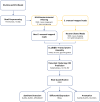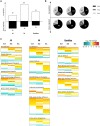Transcriptomic responses of Biomphalaria pfeifferi to Schistosoma mansoni: Investigation of a neglected African snail that supports more S. mansoni transmission than any other snail species
- PMID: 29045404
- PMCID: PMC5685644
- DOI: 10.1371/journal.pntd.0005984
Transcriptomic responses of Biomphalaria pfeifferi to Schistosoma mansoni: Investigation of a neglected African snail that supports more S. mansoni transmission than any other snail species
Abstract
Background: Biomphalaria pfeifferi is highly compatible with the widespread human-infecting blood fluke Schistosoma mansoni and transmits more cases of this parasite to people than any other snail species. For these reasons, B. pfeifferi is the world's most important vector snail for S. mansoni, yet we know relatively little at the molecular level regarding the interactions between B. pfeifferi and S. mansoni from early-stage sporocyst transformation to the development of cercariae.
Methodology/principal findings: We sought to capture a portrait of the response of B. pfeifferi to S. mansoni as it occurs in nature by undertaking Illumina dual RNA-Seq on uninfected control B. pfeifferi and three intramolluscan developmental stages (1- and 3-days post infection and patent, cercariae-producing infections) using field-derived west Kenyan specimens. A high-quality, well-annotated de novo B. pfeifferi transcriptome was assembled from over a half billion non-S. mansoni paired-end reads. Reads associated with potential symbionts were noted. Some infected snails yielded fewer normalized S. mansoni reads and showed different patterns of transcriptional response than others, an indication that the ability of field-derived snails to support and respond to infection is variable. Alterations in transcripts associated with reproduction were noted, including for the oviposition-related hormone ovipostatin and enzymes involved in metabolism of bioactive amines like dopamine or serotonin. Shedding snails exhibited responses consistent with the need for tissue repair. Both generalized stress and immune factors immune factors (VIgLs, PGRPs, BGBPs, complement C1q-like, chitinases) exhibited complex transcriptional responses in this compatible host-parasite system.
Significance: This study provides for the first time a large sequence data set to help in interpreting the important vector role of the neglected snail B. pfeifferi in transmission of S. mansoni, including with an emphasis on more natural, field-derived specimens. We have identified B. pfeifferi targets particularly responsive during infection that enable further dissection of the functional role of these candidate molecules.
Conflict of interest statement
The authors have declared that no competing interests exist.
Figures











Similar articles
-
A Comparison of Kenyan Biomphalaria pfeifferi and B. Sudanica as Vectors for Schistosoma mansoni, Including a Discussion of the Need to Better Understand the Effects of Snail Breeding Systems on Transmission.J Parasitol. 2017 Dec;103(6):669-676. doi: 10.1645/17-72. Epub 2017 Jul 14. J Parasitol. 2017. PMID: 28708450
-
Field-derived Schistosoma mansoni and Biomphalaria pfeifferi in Kenya: a compatible association characterized by lack of strong local adaptation, and presence of some snails able to persistently produce cercariae for over a year.Parasit Vectors. 2014 Nov 26;7:533. doi: 10.1186/s13071-014-0533-3. Parasit Vectors. 2014. PMID: 25425455 Free PMC article.
-
The in vivo transcriptome of Schistosoma mansoni in the prominent vector species Biomphalaria pfeifferi with supporting observations from Biomphalaria glabrata.PLoS Negl Trop Dis. 2019 Sep 30;13(9):e0007013. doi: 10.1371/journal.pntd.0007013. eCollection 2019 Sep. PLoS Negl Trop Dis. 2019. PMID: 31568484 Free PMC article.
-
Epigenetic modulation, stress and plasticity in susceptibility of the snail host, Biomphalaria glabrata, to Schistosoma mansoni infection.Int J Parasitol. 2016 Jun;46(7):389-94. doi: 10.1016/j.ijpara.2016.03.003. Epub 2016 Apr 4. Int J Parasitol. 2016. PMID: 27056272 Review.
-
Successful parasitism of vector snail Biomphalaria glabrata by the human blood fluke (trematode) Schistosoma mansoni: a 2009 assessment.Mol Biochem Parasitol. 2009 May;165(1):8-18. doi: 10.1016/j.molbiopara.2009.01.005. Epub 2009 Jan 22. Mol Biochem Parasitol. 2009. PMID: 19393158 Free PMC article. Review.
Cited by
-
Comparative study of excretory-secretory proteins released by Schistosoma mansoni-resistant, susceptible and naïve Biomphalaria glabrata.Parasit Vectors. 2019 Sep 14;12(1):452. doi: 10.1186/s13071-019-3708-0. Parasit Vectors. 2019. PMID: 31521183 Free PMC article.
-
Transcriptional profiling of Bulinus globosus provides insights into immune gene families in snails supporting the transmission of urogenital schistosomiasis.Dev Comp Immunol. 2024 May;154:105150. doi: 10.1016/j.dci.2024.105150. Epub 2024 Feb 15. Dev Comp Immunol. 2024. PMID: 38367887 Free PMC article. Review.
-
RNA-seq: The early response of the snail Physella acuta to the digenetic trematode Echinostoma paraensei.J Parasitol. 2020 Aug 1;106(4):490-505. doi: 10.1645/19-36. J Parasitol. 2020. PMID: 32726421 Free PMC article.
-
Genomic and transcriptional analysis of genes containing fibrinogen and IgSF domains in the schistosome vector Biomphalaria glabrata, with emphasis on the differential responses of snails susceptible or resistant to Schistosoma mansoni.PLoS Negl Trop Dis. 2020 Oct 14;14(10):e0008780. doi: 10.1371/journal.pntd.0008780. eCollection 2020 Oct. PLoS Negl Trop Dis. 2020. PMID: 33052953 Free PMC article.
-
An Overview of Transcriptional Responses of Schistosome-Susceptible (M line) or -Resistant (BS-90) Biomphalaria glabrata Exposed or Not to Schistosoma mansoni Infection.Front Immunol. 2022 Jan 12;12:805882. doi: 10.3389/fimmu.2021.805882. eCollection 2021. Front Immunol. 2022. PMID: 35095891 Free PMC article.
References
-
- World Health Organization. Schistosomiasis Weekly epidemiological record. 2017. Geneva, Switzerland.
-
- King CH, Dangerfield-Cha M. The unacknowledged impact of chronic schistosomiasis. Chronic Illness 2008;4: 65–79. doi: 10.1177/1742395307084407 - DOI - PubMed
-
- World Health Organization. Prevention and control of schistosomiasis and soil-transmitted helminthiasis. World Health Organization technical report series. 2002. Geneva, Switzerland. - PubMed
-
- Zhou H, Ohtsuka R, He Y, Yuan L, Yamauchi T, Sleigh AC. Impact of parasitic infections and dietary intake on child growth in the schistosomiasis-endemic Dongting Lake Region, China. American Journal of Tropical Medicine and Hygiene. 2005;72: 534–539. - PubMed
MeSH terms
Grants and funding
LinkOut - more resources
Full Text Sources
Other Literature Sources
Research Materials

